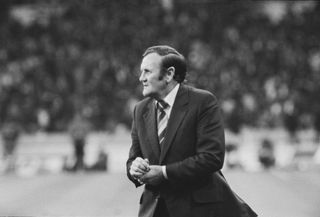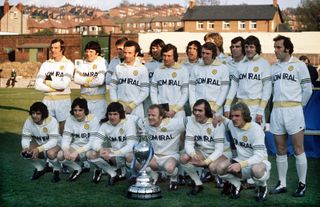The birth of the replica football shirt, 50 years on
It's been half a century since a small Midlands firm went from manufacturing nuns’ knickers to selling the world’s first replica football kits, just in time for Christmas

At what point did football fans stop looking like they'd just finished work and begin wearing shirts like players? Historical clips tell us the sea change happened around the 1980s, but the seed was planted in December 1973 when the first official club replica football shirt went on sale publicly.
You could call it a happy accident. But fifty years ago a modest firm in the Midlands called Admiral managed to open floodgates to a multimillion-pound industry over a cup of tea with then Leeds United and soon-to-be-England boss Don Revie.
Prior to the kettle going on in Revie's office, Admiral had primarily operated as a hosiery brand, world leaders in nuns knicker manufacturing you could say. Between the First and Second World Wars they dabbled in functional clothing for the Navy and this evolved into sportswear, mainly rugby but their ambitious, charismatic, new ower Bert Patrick foresaw the trajectory football was about to embark on.

Riding the wave of the 1966 World Cup and colour television Patrick was trying to drag the company he had joined, and subsequently acquired, into the modern era. But it was his Managing Director John Griffiths who was responsible for the first crack in the glass ceiling of replica.
In October 1973 John and another salesman from Admiral drove 100 miles from Wigston in Leicestershire to Yorkshire for a meeting at a mail-order catalogue business on the outskirts of Leeds.
Armed with some rugby and football jersey samples, they presented their wares to an uninterested buyer and were back on the street inside half an hour. After a consolation full English breakfast at a nearby café, they realised a Leeds United training session was taking place just across the road.

Don Revie’s charges had made an excellent start to the season, and would finish it as First Division champions. The travelling salesman walked across the road, struck up conversation with Revie, and changed football forever.
Get the FourFourTwo Newsletter
The best features, fun and footballing quizzes, straight to your inbox every week.
“Don Revie was coming out through the gate,” he recalled in the book, Get Shirty. “My colleague said, ‘Mr Revie, I’d like you to meet my boss’. Revie stopped, shook hands and asked us what we were doing in Leeds. “I gave him a brief version of how we’d been kicked out of our earlier meeting. He was interested in our samples, then invited us into his office for some tea.
I explained how we were making football jerseys, how we’d got our own brand and were making progress. He said, ‘What could you do for us?’ I said, ‘It depends: what could we do for the home jersey?’ He replied, ‘Very, very little. Nothing. I want it to be all white – I use Real Madrid as an incentive for the players. But you can do what you like with the change strip and the tracksuit’.”
It wasn’t quite a ‘eureka’ moment. The idea to design a professional team’s kits and sell replicas to fans had a gradual evolution. The author of Get Shirty, Andy Wells, tells FFT that the seed may have been planted earlier in 1973.
“John Griffiths told me that a sales rep had gone into one of the local schools or sports clubs,” he says. “A mother had asked, ‘Do you do football kits exactly the same as the players? You know, the badge and the number on the back – identical’. “He said, ‘Oh no, we don’t, actually’. The rep reported back to John, ‘What about this? This is what I’m getting asked about’.

I think that was the moment where they thought, ‘Maybe there’s a market for this’.” Sat opposite Revie in the Leeds manager’s office, the dots began to join up for Griffiths. After a quickfire calculation, he made Revie a deliberately low offer there and then, for a radical arrangement whereby Admiral would pay Leeds for the privilege of manufacturing their playing strips.
Admiral would redesign the kit (staying true to Revie’s request for the Real Madrid look to remain untouched) and, taking advantage of the 1968 Design Copyright Act, register the strip so that only Admiral could legally produce them.
Up until that point, both professional and amateur clubs simply bought generic, off-the-peg strips from retailers. Admiral were proposing to manufacture identical Leeds United kits in children’s sizes to sell to fans, thus covering the cost of the new deal with Revie, as well as manufacturing costs, while also aiming to turn a profit.
To emphasise the infancy of shirt deals in 1973, Leeds took to the field for the first time wearing their Admiral-branded strip in the same month as Griffiths’ training-ground meeting with Revie. As no previous contracts nor regulations were in place, Leeds could do as they pleased, changing kit mid-campaign.
Serendipitously, their first game in the new outfit was at Leicester, just a few miles from Admiral’s factory. The company logo featured on the chest and shorts, but other than that the home strip looked all but identical to the previous Umbro-supplied attire.

Supplying the kit to the team was painless, but Admiral then had to churn out replica strips in time for Christmas. Only children’s sizes were produced initially; it would take the best part of a decade before adult sizes entered the market, though grown-ups were catered for with the tracksuits Admiral had also agreed to make, which the players wore while walking on the pitch prior to kick-off. Tracksuits retailed at about £8, the equivalent of £80 in today’s money.
On December 22, 1973, Bert Patrick and John Griffiths were guests at Elland Road for Leeds’ home game against Norwich. Revie’s team were still unbeaten in the league, the mood was celebratory and the first replica jerseys were officially on sale to the public. “They both congratulated themselves,” Wells tells FFT. “They were really up against it in terms of getting stuff out – had they not got the kits into shops for Christmas, I wonder whether it would have taken off.”
Sales of Leeds’ white home kit, a yellow away top and the tracksuit took even Patrick and Griffiths by surprise – they sold across the entire country, not just around Yorkshire. Admiral’s venture quickly forced everyone in the sportswear world to react.

The seas have been quite rough for Admiral in the half-century since they shook hands with Revie. The company were denounced early on in Parliament for ‘ripping off kids’ with their exorbitantly-priced replica venture: £5 per shirt. That works out at £51.95 today. This season, a child’s shirt for Premier League champions Manchester City retails at £60.
Admiral teamed up with Revie once again in 1974, when he was appointed England manager, and supplied Three Lions shirts for 10 years. They’re one of only three brands to have seen their logo appear on an England jersey, along with Umbro and Nike.
At the height of their success, they made kits for more than 100 clubs and national teams. By the 1980s, however, other brands had caught up and started throwing their weight around. Admiral tried to keep pace, borrowing heavily from banks, but come the middle of the decade their Wigston factory had closed.
While they survived, today they operate on a vastly different scale, dwarfed by the big beasts of the shirt market. Their place in the history of replica kits will remain forever, though. A multimillion-pound industry originated over a cup of tea in Don Revie’s office in 1973. As it happened, selling football shirts proved rather more lucrative than flogging nuns’ knickers.
More features
David Beckham at Real Madrid: The story of how Goldenballs became a Galactico
Ranked! The 10 best Admiral football kits ever
‘Dear Nigel Martyn…’: Rediscovering the childhood letters I wrote to footballers in the '90s

Thank you for reading 5 articles this month* Join now for unlimited access
Enjoy your first month for just £1 / $1 / €1
*Read 5 free articles per month without a subscription

Join now for unlimited access
Try first month for just £1 / $1 / €1

Ketch joined FourFourTwo as Deputy Editor in 2022 having racked up appearances at Reach PLC as a Northern Football Editor and BBC Match of the Day magazine as their Digital Editor and Senior Writer. During that time he has interviewed the likes of Harry Kane, Sergio Aguero, Gareth Southgate and attended World Cup and Champions League finals. He co-hosts a '90s football podcast called ‘Searching For Shineys’, is a Newcastle United season ticket holder and has an expensive passion for collecting classic football shirts.